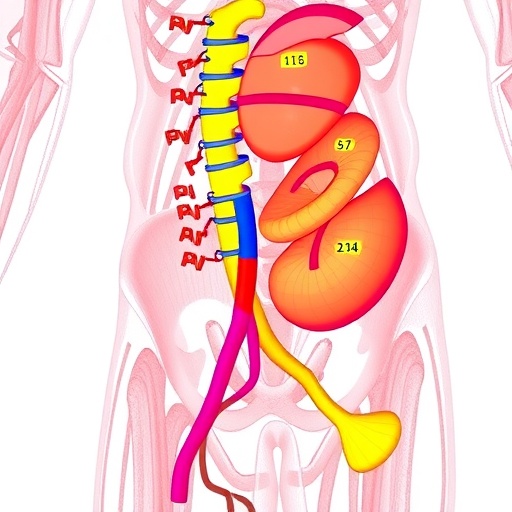In a remarkable advancement in the fight against ovarian cancer, a new study has unveiled a promising strategy to enhance the effectiveness of PARP inhibitors, particularly in overcoming resistance to the chemotherapeutic agent cisplatin. This breakthrough centers on a dual inhibition approach targeting key DNA damage response kinases, ATR and ATM, which significantly increases the susceptibility of both cisplatin-sensitive and cisplatin-resistant ovarian cancer cells to PARP inhibitors. The findings, published in the journal Cell Death Discovery, offer renewed hope for improving outcomes in patients struggling with this notoriously difficult-to-treat malignancy.
Ovarian cancer remains one of the most lethal gynecological cancers worldwide, often diagnosed at a late stage and complicated by the development of resistance to frontline therapies such as platinum-based drugs like cisplatin. While PARP inhibitors have emerged as an effective targeted treatment, especially for tumors with defects in DNA repair pathways, their utility is frequently limited by intrinsic or acquired resistance mechanisms. The research team, led by König and colleagues, addressed this challenge by exploring the synergy between PARP inhibitors and inhibitors of ATR (ataxia telangiectasia and Rad3-related) and ATM (ataxia telangiectasia mutated) kinases, both of which are pivotal regulators of the DNA damage response.
Mechanistically, ATR and ATM play complementary roles in sensing DNA damage and orchestrating repair processes, thereby maintaining genomic stability. ATR primarily responds to replication stress and single-strand breaks, whereas ATM is activated by double-strand DNA breaks. Inhibiting these kinases disrupts the repair of DNA lesions induced by chemotherapy or PARP inhibition, effectively overwhelming the cancer cells’ ability to recover from genomic insult. The study demonstrated that simultaneous blockade of ATR and ATM intensified DNA damage accumulation when combined with PARP inhibitors, triggering catastrophic genomic instability and cell death.
The researchers utilized ovarian cancer cell lines with varying sensitivities to cisplatin to evaluate this combinatorial approach. Notably, they observed that PARP inhibitors alone exerted limited efficacy against cisplatin-resistant cells, a common clinical challenge. However, co-treatment with ATR and ATM inhibitors restored and even enhanced the cytotoxic effect of PARP inhibition in these resistant cells. This suggests that dual inhibition re-sensitizes cancer cells to PARP-targeted therapy by disabling alternative DNA repair pathways that cancer cells exploit to survive cisplatin-induced DNA damage.
To dissect the molecular underpinnings of this phenomenon, the team employed advanced genomic and proteomic analyses, revealing key biomarkers associated with treatment response. They reported an accumulation of DNA damage markers, such as γ-H2AX, along with activation of apoptotic pathways, indicating that the combined therapy induces lethal DNA damage and programmed cell death. Furthermore, suppression of ATR and ATM signaling was shown to abrogate cell cycle checkpoints, preventing cancer cells from pausing to repair DNA and thus pushing them toward mitotic catastrophe.
These findings carry profound implications for the clinical management of ovarian cancer. Current treatment paradigms involve sequential administration of chemotherapy and PARP inhibitors, often leading to the development of resistance and treatment failure. By integrating ATR and ATM inhibition, it may be possible to devise new combination regimens that delay or reverse resistance, prolonging patient survival and quality of life. The study paves the way for clinical trials designed to test the safety and efficacy of this multi-targeted therapeutic approach.
Beyond ovarian cancer, the fundamental biology elucidated here has broader relevance to other tumor types characterized by DNA repair deficiencies or chemoresistance. Combining PARP inhibitors with ATR and ATM blockers could represent a generalizable paradigm to enhance anti-cancer efficacy. Such strategies would harness synthetic lethality—whereby simultaneous defects in multiple repair pathways selectively kill cancer cells—while sparing normal tissues reliant on intact DNA repair mechanisms. Fine-tuning the balance between efficacy and toxicity will be critical in translating these findings into clinical practice.
The research also highlights the importance of understanding tumor heterogeneity and resistance evolution. Cisplatin resistance in ovarian cancer often arises through diverse molecular mechanisms, including restoration of homologous recombination proficiency or upregulation of alternative repair pathways. By targeting central nodes like ATR and ATM, this study demonstrates a way to circumvent such adaptative resistance, reinforcing the value of multi-target inhibition strategies in precision oncology.
As the authors note, further investigations are warranted to characterize optimal dosing, scheduling, and biomarkers predictive of response to combined PARP, ATR, and ATM inhibition. Preclinical models, including patient-derived xenografts, will be instrumental in refining these parameters. Additionally, exploring potential synergistic interactions with immunotherapies could unlock additional therapeutic avenues, as DNA damage-inducing agents are increasingly recognized for their ability to modulate anti-tumor immunity.
Technological advancements in drug development have produced potent and selective ATR and ATM inhibitors now entering early-phase clinical trials. This timely convergence of scientific insight and pharmaceutical innovation sets the stage for rapid translation of König et al.’s findings. Should clinical validation succeed, this tri-modal intervention could revolutionize treatment strategies for patients with platinum-resistant ovarian cancer, currently facing limited options and poor prognoses.
In summary, this study presents a compelling case for combining PARP inhibitors with ATR and ATM kinase inhibitors to overcome cisplatin resistance and enhance therapeutic efficacy in ovarian cancer. By incapacitating cancer cells’ DNA repair machinery on multiple fronts, this approach induces lethal genomic instability and promotes cell death. Given the prevalence of treatment resistance in ovarian cancer, these findings represent a significant breakthrough that could transform patient outcomes and inspire new drug development pathways targeting DNA damage response networks.
The clinical translation of these results will require careful consideration of potential side effects, given the role of ATR and ATM in normal cellular function. Nonetheless, the therapeutic window appears favorable, as cancer cells typically bear higher replication stress and DNA repair demands compared to normal tissues. Tailored strategies that exploit these vulnerabilities promise to maximize anti-cancer efficacy while minimizing collateral toxicity.
Looking forward, the integration of genomic profiling into clinical workflows will support the identification of patients most likely to benefit from this combination therapy. Precision medicine approaches harnessing molecular diagnostics will enable optimization of treatment regimens, ensuring that the multi-target strategy is deployed where it offers maximal benefit.
This research exemplifies the power of targeted inhibition of DNA damage response pathways to overcome resistance and improve cancer treatment. König and his colleagues have provided a foundation for future clinical trials that could reshape therapeutic landscapes for ovarian cancer and beyond, highlighting the continuing importance of mechanistic cancer biology in informing next-generation drug development.
As the oncology community eagerly anticipates clinical results validating this strategy, the promise of overcoming drug resistance through coordinated inhibition of DNA repair kinases marks a thrilling frontier in cancer therapy. This innovative paradigm underscores a central tenet of modern oncology: the thoughtful combination of targeted agents can unlock new therapeutic possibilities where monotherapies fall short, ultimately advancing the quest to defeat cancer.
Subject of Research: Enhanced efficacy of PARP inhibitors in ovarian cancer through ATR and ATM kinase inhibition.
Article Title: Increased efficacy of PARP inhibitors against cisplatin-sensitive and -resistant ovarian cancer cells mediated via ATR and ATM inhibition.
Article References:
König, P., Bade, L., Eichhorn, J.M. et al. Increased efficacy of PARP inhibitors against cisplatin-sensitive and -resistant ovarian cancer cells mediated via ATR and ATM inhibition. Cell Death Discov. 11, 438 (2025). https://doi.org/10.1038/s41420-025-02740-1
Image Credits: AI Generated
DOI: https://doi.org/10.1038/s41420-025-02740-1
Tags: Boosted PARP inhibitor effectivenessCell Death Discovery journal findingsDNA damage response kinasesdual inhibition of ATR and ATMenhancing chemotherapy outcomesimproving patient outcomes in cancerintrinsic and acquired resistance mechanismslate-stage ovarian cancer challengesovarian cancer treatment strategiesovercoming cisplatin resistancesynergy between PARP inhibitors and kinase inhibitorstargeted therapies for ovarian cancer





